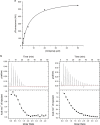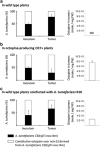Fitness costs restrict niche expansion by generalist niche-constructing pathogens
- PMID: 27801902
- PMCID: PMC5270578
- DOI: 10.1038/ismej.2016.137
Fitness costs restrict niche expansion by generalist niche-constructing pathogens
Abstract
We investigated the molecular and ecological mechanisms involved in niche expansion, or generalism, versus specialization in sympatric plant pathogens. Nopaline-type and octopine-type Agrobacterium tumefaciens engineer distinct niches in their plant hosts that provide different nutrients: nopaline or octopine, respectively. Previous studies revealed that nopaline-type pathogens may expand their niche to also assimilate octopine in the presence of nopaline, but consequences of this phenomenon on pathogen dynamics in planta were not known. Here, we provided molecular insight into how the transport protein NocT can bind octopine as well as nopaline, contributing to niche expansion. We further showed that despite the ability for niche expansion, nopaline-type pathogens had no competitive advantage over octopine-type pathogens in co-infected plants. We also demonstrated that a single nucleotide polymorphism in the nocR gene was sufficient to allow octopine assimilation by nopaline-type strains even in absence of nopaline. The evolved nocR bacteria had higher fitness than their ancestor in octopine-rich transgenic plants but lower fitness in tumors induced by octopine-type pathogens. Overall, this work elucidates the specialization of A. tumefaciens to particular opine niches and explains why generalists do not always spread despite the advantage associated with broader nutritional niches.
Figures





Similar articles
-
Ecological and evolutionary dynamics of a model facultative pathogen: Agrobacterium and crown gall disease of plants.Environ Microbiol. 2018 Jan;20(1):16-29. doi: 10.1111/1462-2920.13976. Epub 2017 Dec 4. Environ Microbiol. 2018. PMID: 29105274 Free PMC article. Review.
-
Structural basis for high specificity of octopine binding in the plant pathogen Agrobacterium tumefaciens.Sci Rep. 2017 Dec 21;7(1):18033. doi: 10.1038/s41598-017-18243-8. Sci Rep. 2017. PMID: 29269740 Free PMC article.
-
Opine-regulated promoters and LysR-type regulators in the nopaline (noc) and octopine (occ) catabolic regions of Ti plasmids of Agrobacterium tumefaciens.J Bacteriol. 1994 Jan;176(2):495-503. doi: 10.1128/jb.176.2.495-503.1994. J Bacteriol. 1994. PMID: 8288543 Free PMC article.
-
Agrobacterium uses a unique ligand-binding mode for trapping opines and acquiring a competitive advantage in the niche construction on plant host.PLoS Pathog. 2014 Oct 9;10(10):e1004444. doi: 10.1371/journal.ppat.1004444. eCollection 2014 Oct. PLoS Pathog. 2014. PMID: 25299655 Free PMC article.
-
Cell-cell communication in the plant pathogen Agrobacterium tumefaciens.Philos Trans R Soc Lond B Biol Sci. 2007 Jul 29;362(1483):1135-48. doi: 10.1098/rstb.2007.2040. Philos Trans R Soc Lond B Biol Sci. 2007. PMID: 17360279 Free PMC article. Review.
Cited by
-
Staphylococcus aureus Host Spectrum Correlates with Methicillin Resistance in a Multi-Species Ecosystem.Microorganisms. 2023 Feb 3;11(2):393. doi: 10.3390/microorganisms11020393. Microorganisms. 2023. PMID: 36838358 Free PMC article.
-
Ecological and evolutionary dynamics of a model facultative pathogen: Agrobacterium and crown gall disease of plants.Environ Microbiol. 2018 Jan;20(1):16-29. doi: 10.1111/1462-2920.13976. Epub 2017 Dec 4. Environ Microbiol. 2018. PMID: 29105274 Free PMC article. Review.
-
Structural basis for high specificity of octopine binding in the plant pathogen Agrobacterium tumefaciens.Sci Rep. 2017 Dec 21;7(1):18033. doi: 10.1038/s41598-017-18243-8. Sci Rep. 2017. PMID: 29269740 Free PMC article.
-
Reconstruction and analysis of a genome-scale metabolic model for Agrobacterium tumefaciens.Mol Plant Pathol. 2021 Mar;22(3):348-360. doi: 10.1111/mpp.13032. Epub 2021 Jan 12. Mol Plant Pathol. 2021. PMID: 33433944 Free PMC article.
-
Opportunistic Bacteria of Grapevine Crown Galls Are Equipped with the Genomic Repertoire for Opine Utilization.Genome Biol Evol. 2023 Dec 1;15(12):evad228. doi: 10.1093/gbe/evad228. Genome Biol Evol. 2023. PMID: 38085065 Free PMC article.
References
-
- Abrams PA. (2006). The prerequisites for and likelihood of generalist-specialist coexistence. Am Nat 167: 329–342. - PubMed
-
- Abrams PA. (2012). The eco-evolutionary responses of a generalist consumer to resource competition. Evolution 66: 3130–3143. - PubMed
-
- Akakura R, Winans SC. (2002). Constitutive mutations of the OccR regulatory protein affect DNA bending in response to metabolites released from plant tumors. J Biol Chem 277: 5866–5874. - PubMed
-
- Blanc E, Roversi P, Vonrhein C, Flensburg C, Lea SM, Bricogne G. (2004). Refinement of severely incomplete structures with maximum likelihood in BUSTER-TNT. Acta Crystallogr D Biol Crystallogr 60: 2210–2221. - PubMed
MeSH terms
Substances
LinkOut - more resources
Full Text Sources
Other Literature Sources

